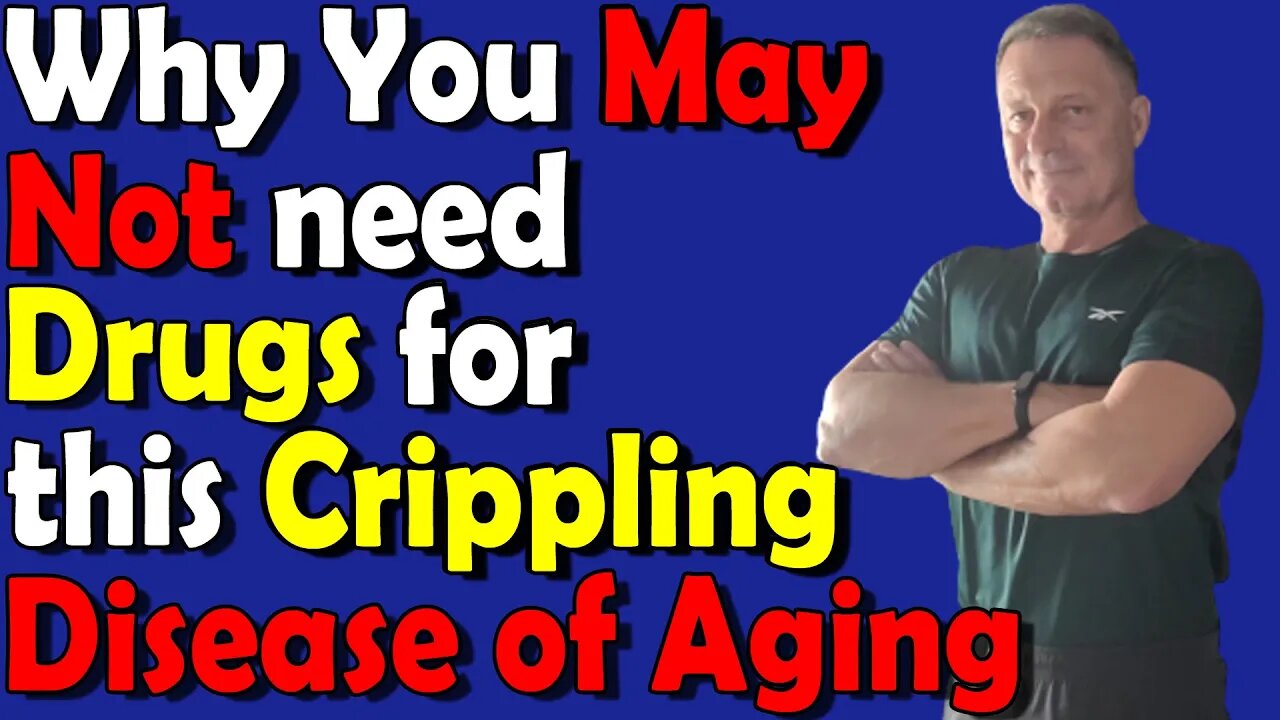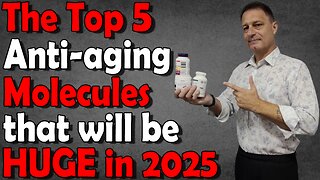Premium Only Content

This Simple Hack May Help This Crippling Disease of Aging
a study out of America has looked into a novel way of addressing a crippling age-related condition that affects over 28% of over the 60’s worldwide.
I hope you enjoy my content and find it interesting or informative, if so, please consider supporting the channel by using one of the affiliate links below:
* Buy me a Kofi: https://ko-fi.com/mynmnexperiment
* Patreon: https://bit.ly/3hhfjl5
* SubscribeStar: https://bit.ly/3psYo23
Youth & Earth 15% Discount Code: MYNMN (https://youthandearth.com?sca_ref=3766764.knrWl4O3cB)
ProHealth 15% Discount Code: MYNMN (https://www.prohealth.com/)
DoNotAge 10% Discount Code: MYNMN (https://bit.ly/2VBDgNt)
Renue by Science 10% Discount Code: MYNMN (https://renuebyscience.com/?rfsn=5692699.331801&coupon-code=MYNMN)
Renue by Science 15% Subscription Service Discount Code: MYNMNSUB
Please note that the links above are affiliate links, which means that if you use the code, I will receive a small commission, and if you do, may I say many thanks I advance for your support.
My Current Anti-Aging Protocol:
• 1.5 grams of NMN (https://bit.ly/3c2Fxt8)
• 1.5 grams of Trans-resveratrol (Tue, Thu & Sat) (https://bit.ly/3yxeqy2)
• 500mg Metformin
• 1.5 grams of TMG (https://bit.ly/3oe1Ted)
• 5,000 IU (International Units) of vitamin D3 (https://bit.ly/3P32hYH)
• 120 mcg (micrograms) of vitamin K2 (Mk 7) (https://bit.ly/3PhkBgn)
• 250mg Magnesium (L-Threonate) (https://bit.ly/3O4pZ5o)
• 200mg high molecular weight hyaluronic acid (https://bit.ly/3P0Z4c2)
• 2,400mg of Fisetin, on the 1st, 2nd & 3rd of each month (https://bit.ly/3P2rSB0)
• 2,400mg of Quercetin, on the 1st, 2nd & 3rd of each month (https://bit.ly/3IzulAy)
• Quercetin & Fisetin Periodic Dosing (https://bit.ly/3mw1IgN)
• 81mg of aspirin (https://bit.ly/3uFjtem)
• 800mg SIRT6 Activator (https://bit.ly/3MyfA4J)
• 600mg DIM (https://bit.ly/3ZX9NsG)
• 800mg GlyNAC (https://shorturl.ac/7b75r)
Links:
https://journals.sagepub.com/doi/10.1177/20494637211026049
https://shorturl.ac/7bc3b
https://shorturl.ac/7bc3c
https://wrap.warwick.ac.uk/153646/
https://www.healthline.com/health/osteoarthritis
https://www.cdc.gov/arthritis/basics/osteoarthritis.htm
It may shoot through your hands while typing or flare up in your knees when getting out of the car or out of the bath, but wherever the pain is, over 32 million Americans, and an estimated 10% of all men and 18% of women over the age of 60, worldwide, are living with osteoarthritis, and the pain and physical limitations that it brings with it. To reduce that constant pain, patients living with the crippling condition are often told by their doctors to simply exercise. It sounds simple, but people with osteoarthritis may experience pain when they start to move more, which can be a deterrent to taking up, or sticking with, any exercise program.
Daniel Whibley PhD, an Assistant Professor of Physical Medicine & Rehabilitation at the University of Michigan said "Pain during movement is an important reason why this population isn't more active, and we need to identify ways we can help to change this.
Otherwise, they may end up in a loop of pain and inactivity that we know can lead to disability later down the line."
A growing body of research suggests that maintaining good sleep health, more specifically high-quality sleep for an appropriate duration, in patients with osteoarthritis may reduce their pain and discomfort.
There is also strong evidence supporting links between sleep and being physically active.
Professor Whibley stated that "If you're sleeping well, you're more likely to be able to move more the next day or stick with a planned exercise program. And those who are physically active during the day are more likely to get a good night's sleep.”
Professor Whibley's team looked to develop a new intervention that brought together insights from previous research that supports these relationships.
What hasn't been investigated yet is whether simultaneously targeting both sleep and physical activity - and the optimal balance between them – will result in better pain outcomes. With his team of researchers, Professor Whibley introduced the concept of a hybrid sleep-exercise program, that observed focus groups composed of people living with BOTH OA related pain and sleep disturbances.
The sleep component of this intervention is an automated program called Sleepio. Sleepio delivers cognitive-behavior therapy for insomnia over the internet, as well as components focused on sleep education and behavior modifications to sleep routines.
FAIR-USE COPYRIGHT DISCLAIMER
Copyright Disclaimer Under Section 107 of the Copyright Act 1976, allowance is made for "fair use" for purposes such as criticism, commenting, news reporting, teaching, scholarship, and research. Fair use is a use permitted by copyright statute that might otherwise be infringing. Non-profit, educational, or personal use tips the balance in favor of fair use. #Arthritis #Osteoarthritis #Healthspan
-
 6:07
6:07
My Longevity Experiment
6 months ago $0.05 earnedTop 5 Longevity Supplements for 2025 | A Data Driven List
1563 -
 15:23
15:23
Mrgunsngear
10 hours ago $0.29 earnedSig Sauer Enclosed Sig Loc Romeo-X Compact Red Dot Torture Test & Review
2.07K1 -
 LIVE
LIVE
PandaSub2000
1 day agoLIVE 9pm ET | PICTIONARY & ANTICIPATION with Chat!
104 watching -
 LIVE
LIVE
megimu32
1 hour agoON THE SUBJECT: The Villains We Loved to Hate - Childhood Trauma Reloaded
109 watching -
 LIVE
LIVE
SpartakusLIVE
5 hours ago#1 Verdansk HERO || Live EARLY off EARLY
95 watching -
 LIVE
LIVE
Precision Rifle Network
1 day agoS4E21 Guns & Grub - New Optics and Chronographs
40 watching -
 7:28:28
7:28:28
Dr Disrespect
10 hours ago🔴LIVE - DR DISRESPECT - WARZONE VERDANSK - EXTREME CHALLENGES
149K7 -
 26:31
26:31
Glenn Greenwald
7 hours agoTrump at the NATO Summit: Michael Tracey Reports from The Hague | SYSTEM UPDATE #477
91.5K14 -
 1:40:56
1:40:56
RiftTV/Slightly Offensive
6 hours agoSHOCKING: Pro-Israel Extremist CRUCIFIES Christian Pastor | The Rift
25.3K4 -
 LIVE
LIVE
The Breanna Morello Show
8 hours ago $1.74 earnedAutopen Scandal Gets Worse, Commie Take Over in NYC?, FBI Whistleblowers Need Help, Dividing MAGA- The Breanna Morello Show
269 watching